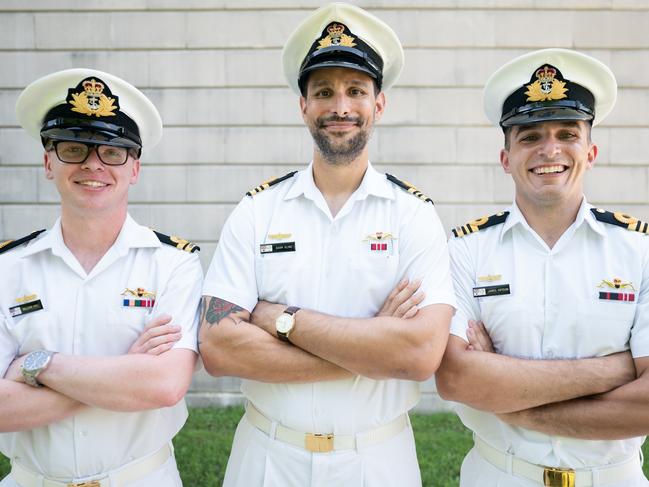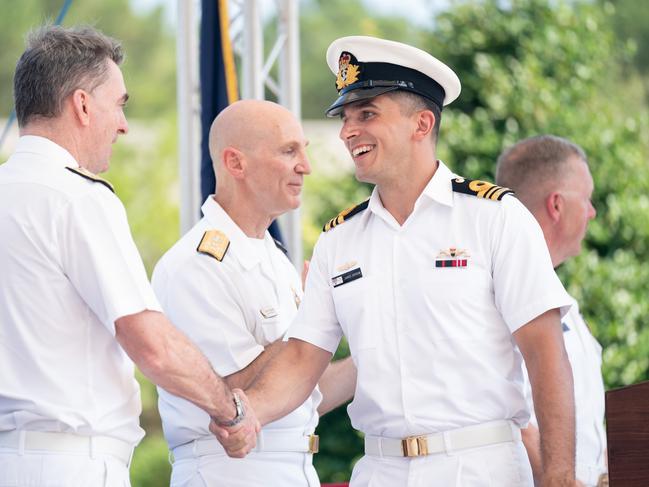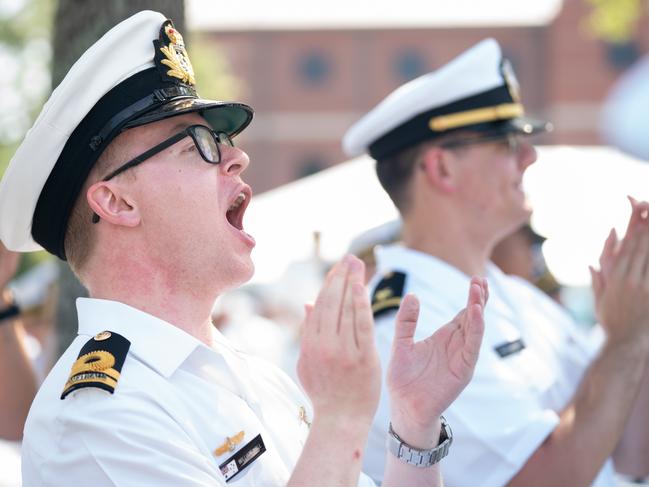Three Aussie submarine officers graduate from elite US nuclear school
Australian Navy bosses have revealed plans to develop a national high-performance submarine academy, as three Aussie officers graduate from an elite US school. See the video.
National
Don't miss out on the headlines from National. Followed categories will be added to My News.
Three Australian submarine officers have graduated from America’s elite nuclear school in what our Navy chief has hailed as a historic achievement that will turbocharge the AUKUS partnership.
The officers will join the crew of a US Virginia-class submarine in Hawaii next year, saying they are “the tip of the spear” in Australia’s $368bn bid to acquire a nuclear-powered fleet.
Six more Australians are now studying at the US Navy’s Nuclear Power School in Goose Creek, South Carolina, a number that will rise to 30 next year in an accelerating effort to ensure we can man our boats when they hit the water in about a decade.

And it can be revealed that Australian Navy bosses are eventually planning to replicate the American high-performance academy down under, either in Perth or Adelaide, with the first US graduates expected to help lead the way.
Australian Chief of Navy Vice Admiral Mark Hammond, who was in Goose Creek for the graduation ceremony, said it was a “historic event for our nation” that was “a little bit surreal” after the rapid development of AUKUS.
“We’ve come a long way in such a short period of time, but there’s a lot more work to do,” he said.
“That journey is about to be turbocharged.”
Vice Admiral Jonathan Mead, the Australian Submarine Agency’s Director-General, said: “Today, we have sharpened the tip of our undersea warfighting spear and we are closer to having a safer and more secure Indo-Pacific region.”

The Nuclear Power School is a six-month theoretical course on nuclear reactors including chemistry, physics, maths and thermodynamics.
While none of the three Australians had a background in nuclear science or engineering, the school’s commanding officer Captain Jason Anderson said they passed with flying colours.
Lieutenant Commander James Heydon, 31, described it as a “four-year engineering degree crammed into six months”.
“It was a crash course into the deep end – sink or swim, and we all swam,” he said.
Lt Cmdr Heydon – along with fellow Queenslanders Lieutenant Commander Adam Klyne, 39, and Lieutenant William Hall, 25 – will spend the next six months at the Nuclear Power Training Unit in Charleston, testing their knowledge in simulations and on retired boats.
They will then complete the 12-week Submarine Basic Officer Course before heading to Pearl Harbour for what is expected to be a three-year tour of duty on an American nuclear submarine.

Lt Cmdr Klyne said he was learning “the skills, knowledge and attitude to repatriate back to Australia so we’re sovereign ready for our first Virginia”.
“Being a submariner is a little bit strange in and of its own right, but the challenge of operating and leading teams in nuclear-powered propulsion is something that really appealed to me,” he said.
Lt Hall agreed, saying he “couldn’t pass up” the chance to be one of Australia’s first nuclear submarine officers.
Their instructor Lieutenant Steven Reidel said they were “great students” who were “fully immersed” in the American program.

Vice Admiral Hammond said the officers would eventually need to “pay their skills forward” back home as the Navy worked to meet the workforce demands of AUKUS.
Australia will receive at least three American nuclear-powered submarines in the early 2030s before the Australian-made SSN-AUKUS boats hit the water in the early 2040s.
The Chief of Navy said recruitment and training was a “complex challenge” but that he was aiming to prepare as many nuclear-ready officers as “humanely and legally possible”.
“We’ve got a heck of a lot to offer Australia’s youth,” he said.
“You want to see the world? Come and join the Australian Navy.”
Vice Admiral Hammond said while Australians would continue to train in the US for years to come, as part of a “deep and enduring partnership” with the Nuclear Power School, a domestic facility would be needed as well.
“If we’re serious about developing a sovereign nuclear submarine capability, then in time definitely, all parts of the ecosystem built and operated by Australians in Australia,” he said.

It would most likely be in Perth – as the future home port for Australian nuclear submarines – or Adelaide, although Vice Admiral Hammond said that would be a decision for the federal government.
US Command Master Chief Brandon Busch said safety was the top priority of its program, based on 270 million kilometres travelled over almost 70 years by American nuclear submarines without any major incidents.
“We’re teaching them how we do it safely so the Australians go and generate their own nuclear propulsion program,” he said.
“This is definitely a team sport – we can’t do it alone, Australia can’t do it alone.”
More Coverage
Originally published as Three Aussie submarine officers graduate from elite US nuclear school




